Bigger pipes in space for handling the data explosion
Observing the planet from space could help manage disasters, monitor climate change and help farmers and people tracking wildlife. But the growth of Earth Observation (EO) is being held back by the lack of capacity for getting the data from the satellites back to earth. Researchers from the RAVEN project are aiming to fix this bottleneck by developing optical feeder links which can do this in real time. Until not so long ago, a satellite would have cost EUR 100 million to build and be about the size of a double decker bus. But the advent of smaller, cheaper cube satellites is changing all this and, in the process, lowering the entry barriers to space. “Where before space was dominated by government bodies, now it is becoming a place to do business,” says John Mackey, RAVEN project coordinator and CEO of photonics specialists mBryonics of Galway, Ireland. One example is Planet Labs, set up by ex-NASA scientists in 2010, which recently began imaging the earth on a daily basis. Worn-out pipes Such initiatives are regularly generating petabytes of data, but the pipes for bringing the data down to earth are beginning to show their age. This is where RAVEN comes in. “We are creating whole new pipes for sat coms which are likely to revolutionise how satellites can be used for communication purposes,” says Mr. Mackey. mBryonics has developed an intelligent architecture for optical communications in space that can link a constellation of satellites in an automated, transparent way and creates a virtualised distributed ground segment. “It minimises the number of ground stations you need and allows you to get that data down… in near real time,” says Mr Mackey. This photonics system can not only handle 10 gigabytes per second of data but is also considerably lighter and cheaper than existing solutions. “We have managed to miniaturise the whole system down with a revolutionary SWaP (size,weight and power) and the price point is considerably less, so it is suitable for small platforms and mass production,” says Mr Mackey. Optical brains The team has developed an ArcLight™ modem – an optical software –defined network which acts as a kind of optical brain allowing satellites to communicate with each other. They have also used RAVEN funding to explore the potential of EO from High Altitude Platforms – constellations of balloons, airships or drones which fly 20 kilometres above the earth in the stratosphere. As well as advancing the technology, mBryonics has used the six-month duration of RAVEN to talk to key stakeholders in the satcom ecosystem about what they need from a photonics system. “H2020 is a nice door-opener when you want to have conversations with people as it gives prestige,” says Mr Mackey. The team now has a prototype adaptive optics phased array feeder system and plans to apply for RAVEN II funding to develop it further. The future looks bright for this kind of technology, they believe, and not only for EO. The coming explosion in data, driven by developments such as the launch of 5G mobile in 2020, means existing networks will be unable to cope, predicts Mr Mackey. "When it comes to 5G, the data crunch is going to be phenomenal — earth-based systems will be overwhelmed and satellite systems will come into their own to backhaul data as a kind of alternative routing option," he says, "the bi-directional feeder system will be key because you will need to route the data in an intelligent way."
Keywords
RAVEN, optical feeder links, satcoms, Earth Observation, photonics, 5G, data explosion, SmallSat, adaptive optics, phased arrays, virtualisation







